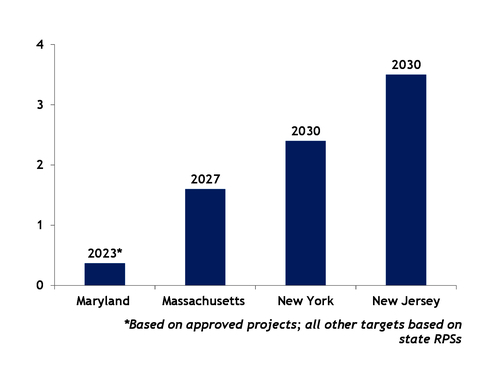Plans to convert Massachusetts' Brayton Point coal plant into a hub to support offshore wind development could be a sign of things to come for the state and the region.
The site, once home to New England's largest coal-fired power plant, has drawn interest from investors and regulators who are eager to launch the state's offshore wind industry. Its redevelopment provides a glimpse of how the sector could take root along the coast of the US northeast.
Power supplier Dynegy last week said it had reached an agreement to sell the 307-acre site to the Commercial Development Company, which will repurpose it to serve as a staging area to build out Massachusetts' offshore wind fleet. The state is aiming to achieve 1,600MW of offshore generation by 2027 — up from zero today.
"We are currently looking at Brayton Point as a prime location to interconnect our Bay State Wind project to the on-shore electrical transmission grid," Eversource said.
"Brayton Point could be redeveloped to accommodate essentially any and all activities associated with offshore wind including staging, deployment, manufacturing, operations and maintenance," according to the Massachusetts Clean Energy Center, which last month included the site in an assessment of 18 waterfront properties that could support offshore wind.
The site has a local population that is accustomed to an industrial presence and "one of the largest available acreages on the waterfront in the northeast," the assessment says.
The announcement of the site sale comes just ahead of the 20 December deadline for offshore wind developers to submit proposals to a Massachusetts solicitation for the first 400-800MW to be built off the state's coast. Bids must be a minimum of 400MW.
Three entities — Deepwater Wind, Vineyard Wind and Bay State Wind — hold offshore wind leases along the Massachusetts coast. Each is expected to bid next month and could use Brayton Point has the anchor for their projects.
It is unclear for now how many hubs will be needed to support the projects needed to hit the state's 2027 goal, but four other locations in and near Somerset, where Brayton Point is located, are putting out the welcome mat for developers. Also, the state has launched the New Bedford Marine Commerce Terminal, a 28-acre port designed specifically for offshore wind projects.
Much of Brayton Point's attraction stems from its pre-existing transmission infrastructure. The nascent state of US offshore wind means that projects will need transmission lines to bring the power to land. The site's former life as a coal plant means that its electric lines can now be re-tooled for wind, at a substantially lower cost than building transmission from scratch. Offshore projects in New York have come under scrutiny for their lack of transmission infrastructure.
Brayton Point could offer transmission for between 200-800MW of offshore power, Eversource said. The utility has partnered with Danish firm Orsted in the Bay State Wind project.
Among US east coast states, Massachusetts is especially confident that it can land the investments needed to launch an offshore hub.
"I do not think anybody realizes how big offshore wind will be," said Bill White, the Clean Energy Center's senior director for offshore wind. "We are hoping to make it as easy as possible for developers to select Massachusetts."
White considers Massachusetts "a bit ahead of the other states," which could translate to an early-mover advantage as it lays the foundation for a future industry.
But repurposing Brayton Point will take some time. Commercial Development first has to clean up the site over the next 24-36 months before any wind-related development begins, the company said.
Brayton Point's metamorphosis will take further shape when the company holds a stakeholder meeting in the nearby town of Somerset in January. Massachusetts' plans to build a 1,600MW offshore wind fleet should continue to develop before and after that event. Brayton Point's near-term progress could be an early indicator of offshore wind's prospects in Massachusetts and along the US east coast.



